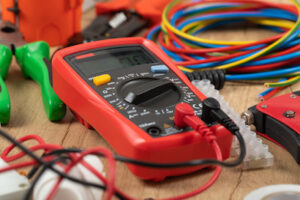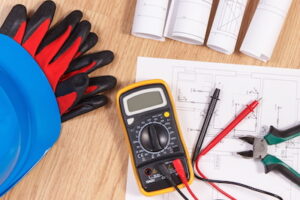How To Check the Electrical Wiring in Your Home Guide
Want to know how to check the electrical wiring in your home? As a homeowner, it’s important to regularly inspect your electrical system to ensure it’s in proper working condition — just think how many appliances you have that rely on this power source.
Have you wondered how to check the electrical wiring in your home with a multimeter? Use these simple steps:
- Prepare your workspace
- Access the wiring
- Check for continuity
- Reinstate the Switch
With the right tools and know-how, some checks are straightforward enough to carry out yourself — this is what I want to show you. In this guide, I’ll walk you through the steps to safely and effectively check your wiring, and also help you understand when to call in the experts.

Safety Precautions When Checking Electrical Wiring
Working with electricity can be dangerous if proper precautions aren’t taken. Before checking your home’s electrical wiring, be aware of the potential hazards and what you can do to stay safe.
Turning off the power
Before starting any work with electrical equipment, it’s important to switch off the power to the area you’ll be working in. This can be done by disconnecting the circuit in the electrical panel or by unplugging appliances and devices. However, it’s essential to consider the type of task being performed and adjust the power status accordingly. Some tests require a live circuit.
Protective gear for working with electricity
Appropriate apparel should be worn. This includes rubber-soled shoes, long sleeves, safety glasses, and gloves. These provide an extra layer of protection in case of accidental electrical contact.
Using electrical tools and equipment
To minimize the risk of electric shock, it’s vital to use insulated tools and equipment that’s safety rated for the purpose.
Don’t test near water
Wet floors, wet hands — never test electrical wiring if you spot any signs of moisture.
Knowing When to Call an Expert to Check Your Electrical Wiring in Your Home
While checking your home’s electrical wiring can be done by homeowners, it’s important to know when it’s time to call in an expert. If you:
- Aren’t comfortable or confident in your ability to safely check the wiring.
- Come across any issues that you aren’t able to fix on your own, such as frayed wires or a malfunctioning circuit breaker.
- Find any evidence of water damage or corrosion on the wiring — this can be a sign of a serious problem.
- Have an old or outdated electrical system that needs upgrading.
- Are planning a home renovation or addition that will require changes to the electrical wiring.
Why Would You Test Electrical Wiring in Your Home?
There are several reasons — testing your wiring enables you to:
Identify Potential Hazards
Whether it’s frayed wires, loose connections, or an overloaded circuit — testing helps you troubleshoot. Issues with your wiring can increase the risk of electrical fires, or shocks and should be addressed immediately.
Prevent Power Outages
By identifying and fixing any issues with the wiring, you can prevent power outages and ensure that your home’s electrical system is running smoothly.
Save Money
Regularly testing and maintaining the electrical wiring can save you money in the long run — preventing costly repairs or replacements.
Improve Energy Efficiency
By testing the wiring and identifying any issues, you can improve the overall energy efficiency of your home, which can help to reduce your energy bills.
Ensure Safety
The most important reason to test the electrical wiring is to ensure the safety of yourself, your family, and your home.
Types of Electrical Testing Equipment
There are various ways to check the electrical wiring in your home — you can use one of the following:
- Multimeter: A device with multiple functions that’s useful for checking continuity in wires and circuits, as well as measuring the voltage, resistance, and current.
- Electrical test kit: This kit includes a combination of testing tools — such as a voltage tester, circuit tester, and continuity tester.
- Voltage Tester Pen: This tool is used to check for the presence of voltage in wires and circuits. It’s simple to use and handy for testing in tight spaces.

How To Test Home Electrical Wires With a Multimeter — Step-by-Step Instructions
Most electrical problems are caused by loose wires, faulty sockets or switches, or damaged cables. Using a multimeter’s continuity setting can identify these issues safely and quickly.
Below are the steps for checking a house light switch that doesn’t illuminate a bulb when switched on. Although a similar method can be applied to appliances and sockets. The steps below assume the lamp and bulb are in good working order.
1st Step — Preparation
- Put on your protective gear and gather together your equipment.
- Switch off the mains supply, and remove the relevant circuit breaker.
2nd Step — Access the Wiring
- Using your screwdriver, remove the faceplate from the back box.
- Gently pull away the plate to expose the internals and wires.
- Check the wires are connected to the switch — give them a gentle tug to ensure they’re secure.
- If loose, or not connected, reattach to the correct terminal screw.
- Visually examine the wires for damage or breakage. If there’s an issue — consult an electrician to replace it.
3rd Step — Check for Continuity
- Switch on your multimeter and set it to the continuity setting — usually indicated by a loudspeaker system.
- Put one probe onto the hot wire (red or black) terminal screw, and the other onto the neutral wire (white or gray) screw.
- If you hear a beep, this indicates continuity, meaning power is passing through the switch.
- This shows that the problem is not with the switch itself — the problem is occurring further along the circuit. In this circumstance, speak to an expert technician.
- If there is no audible sound — this means no power is passing through the switch. This can be due to:
i) A faulty switch — replace.
ii) Broken neutral or hot wire before or after the switch — speak to an electrician.
4th Step — Reinstate the Switch
- Reattach the face plate to the back socket box — ensuring you don’t trap any wires.
- Replace the circuit breaker.
- Switch the mains supply back on.
Conclusion
Regularly checking your electrical wiring is important for ensuring the safety and functionality of your home.
While you now know how to check the electrical wiring in your home, always follow safety precautions, use the appropriate tools and materials. And, call in a professional if you encounter any issues you’re unsure how to handle.

How To Check the Electrical Wiring in Your Home FAQs
Does Wearing Shoes Prevent Electric Shock?
Wearing shoes does not necessarily prevent electric shock, but it can provide an additional layer of protection. Rubber-soled shoes are especially effective as they’re non-conductive and can help to insulate your feet from the ground.
Is It Safe to Touch Live Wire With Bare Hands?
No, it’s not a good idea. Live wires carry a dangerous amount of electrical current and can cause serious injury or even death.
How Do I Know if a Cable Is Live?
One of the easiest ways to determine if a cable is live is by using a voltage tester. This tool will indicate if there is voltage present in the circuit.
Another way to check if a cable is live is by using a multimeter. This device is a versatile tool that can measure voltage, current, resistance, and more. To use a multimeter, you’ll need to set it to the “voltage” setting and touch the probes to the wires or cables you want to test. If the meter shows a reading, the cable is live.
Are Voltage Test Screwdrivers Safe?
Voltage-test screwdrivers can be a convenient and safe tool to use when checking for electrical power.
When used properly, these testing tools can help you avoid accidental contact with live electrical wires. However, it’s critical to note that voltage-test screwdrivers are not a substitute for proper safety precautions when working with electricity.
